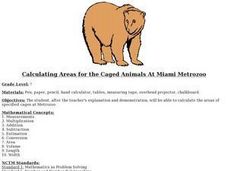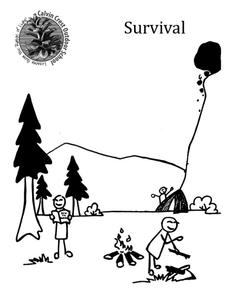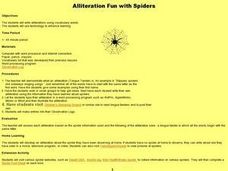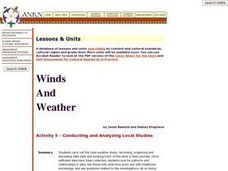Curated OER
Petri-fied of Bacteria
Students examine the existence of bacteria all around them and consider the roles, both positive and negative, that bacteria play. Over a period of several days, students conduct an experiment in which they predict, determine, log, and...
Curated OER
Becoming Comfortable with the Navigation Features
Students, while in the computer lab, log in and go to the American Education System to complete a lesson on the American Education System unit. They review all the terms they may see pop up on their screens (link, save, shift, space,...
Curated OER
Introduction To Bug Collecting
Students explore process of live collection of insects and spiders using sweep nets, aerial nets, and beating sheets. they collect, examine and release several different types of insects or spiders then compare their journal drawing of...
Curated OER
Exploring With Photograms
Students observe the interaction between energy absorbed, reflected or transmitted through an object in a photochemical process with a classroom demonstration.
Curated OER
The Great Backyard Bird Count
Young scholars study new types of birds and explore how to keep a log of what they see.
Curated OER
And The Winner Is
Learners investigate the concept of The MTV Awards shows and how they have been used to form the culture of a generation over time. They view rerun episodes of the shows and write reflectively about observations that are made.
Curated OER
Comparing Amount of Rainfall in Different Geographical Areas
Students construct rain gauges and use them to log rainfall in their school zone, local city, and region and then compare and discuss them by plotting this information.
Curated OER
Calculating Areas for the Caged Animals At Miami Metrozoo
Seventh graders calculate the area of certain cages at the Miami Metrozoo after observing a teacher demonstration.
Curated OER
Get the Facts
Students explore spiders. In this spider instructional activity, students fill out KWL charts, discover facts about spiders and how to identify different spiders. Students research spiders on the Internet and do online activities.
Curated OER
Invertebrates, No Backbone, No Problem
Third graders research an invertebrate, create a poster about it, then present it to the class.
Calvin Crest Outdoor School
Survival
Equip young campers with important survival knowledge with a set of engaging lessons. Teammates work together to complete three outdoor activities, which include building a shelter, starting a campfire, and finding directions in the...
Cornell University
Bridge Building
Bridge the gaps in your knowledge of bridges. Individuals learn about bridge types by building models. The activity introduces beam bridges, arch bridges, truss bridges, and suspension bridges.
Curated OER
Alliteration Fun with Spiders
Students practice using vocabulary words to write alliterations. For this language arts lesson, students collaborate with classmates to create ideas for fun alliterations as they create their own using a children's word processing...
Curated OER
Apple: Seed to Tree
Students grow seeds of an apple and learn about Johnny Appleseed. For this apples lesson plan, students map Johnny Appleseed's travels, learn how he got his name, compare different Johnny Appleseed books, and grow apple seeds themselves.
Curated OER
Have Respect
Students learn the value of respect. In this Clifford the Big Red Dog lesson plan, students read the story, discuss respect, and experience a mini-international festival.
Curated OER
How Caves Are Formed
Learners explore caves. In this cave formation lesson, students take a virtual tour of a cave and then participate in a scientific investigation that requires them to grow crystals and chart data regarding their growth.
Curated OER
Magnetism: What is a Magnetic Field?
Students make a compass. In this magnetism lesson, students use the Internet to research magnetic fields and perform an experiment to find the magnetic fields around different magnets. Students use the Internet to research...
Curated OER
English Literature Circle Discussion
Young scholars participate in literary circles to analyze characters, critique writing, discuss events, and story elements. In this literary circles instructional activity, students take responsibility for their learning as a...
Curated OER
How Trashy Are You?
Students determine the amount of trash a teenager produces. In this environmental instructional activity, students use a garbage bag to collect trash during a twenty-four hour period. Students weigh their bags at the end of the...
Curated OER
Identifying Anger Triggers
Learners, while in the computer lab on Inspiration, visit angermgmt.com and then brainstorm additional anger triggers on a concept map together in groups. Once completed, they identify two new anger management strategies to try out in...
Curated OER
Termite Trail Marking Behavior
Young scholars examine termites and their trail-marking behaviors. They draw lines on paper with various ink pens and experiment to see which types of ink the termites follow--or which inks do and do not elicit trail marking behavior.
Curated OER
Conducting and Analyzing Local Studies
Students carry out the class weather study: recording, organizing and discussing data daily and keeping track of this work in their journals. They look for patterns and relationships in data, link these with what they know and with...
Curated OER
Breaking Color Barriers
Students compare brown eggs and white eggs. In this color lesson, students see two different color eggs and predict what they will look like on the inside. They see that both eggs are the same and compare this to people of different...
Curated OER
Frogs: Fact or Folklore
Students discover how frogs are adapted to their environment. They view and discuss a Discovery Channel video on frogs and the myths surrounding frogs. In small, groups they compile data on frogs from the internet to create a Frog Fact...

























